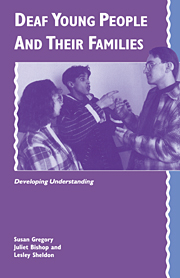Book contents
- Frontmatter
- Contents
- Preface
- Acknowledgements
- 1 The young deaf people and their families
- 2 Family life and communication
- 3 Experiences of education
- 4 The world of work
- 5 Deaf young people in a hearing world
- 6 Friendships, relationships and social life
- 7 Being deaf
- 8 The family and the young deaf person
- 9 Reflections
- References
- Appendices
- Index
6 - Friendships, relationships and social life
Published online by Cambridge University Press: 26 March 2010
- Frontmatter
- Contents
- Preface
- Acknowledgements
- 1 The young deaf people and their families
- 2 Family life and communication
- 3 Experiences of education
- 4 The world of work
- 5 Deaf young people in a hearing world
- 6 Friendships, relationships and social life
- 7 Being deaf
- 8 The family and the young deaf person
- 9 Reflections
- References
- Appendices
- Index
Summary
I have no friends round here. I stay at home by myself. I talk to myself, I am more calm and peaceful without people.
Christopher, 21 years, BSLJane has been her friend since she was 12 years old. She still writes to most other friends from being in junior school. She is still in contact with a lot of friends from D … school. They still visit. There is someone in America she writes to, and someone in Australia. She makes friends wherever she goes.
Mother of Amanda, 20 years, SSEIn the last three chapters we have considered the young people in the public worlds of school, college, work and the general public domain. We now move back into a more private sphere, that of friendships and personal relationships, and look at the social life of the young people. As we look at this topic, a complex picture emerges. Firstly, it is clear that some of the young deaf people enjoyed a rich and varied social life, often involving them in travel all over the country. On the other hand, it emerged that some were extremely lonely at times, felt isolated and had difficulty in making friends and sustaining friendships.
Table 6.1 sets out the friendship pattern of the young people as described by the parents and the young people, combining information obtained from a number of questions in each interview. The use of the category ‘no friends’ was very strictly applied and only used in the absence of evidence of any social contacts at all.
- Type
- Chapter
- Information
- Deaf Young People and their FamiliesDeveloping Understanding, pp. 154 - 180Publisher: Cambridge University PressPrint publication year: 1995



